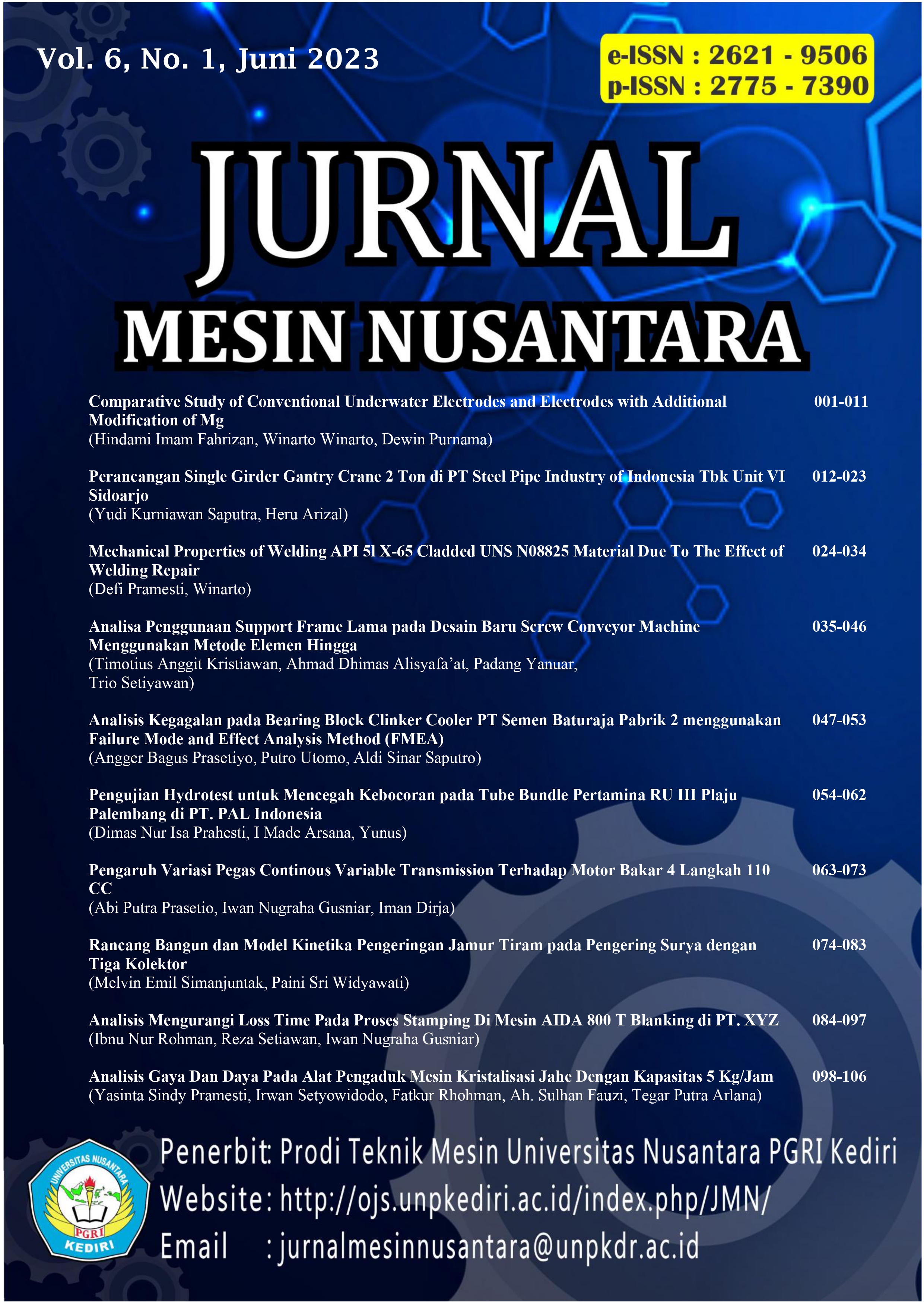Analisis Kegagalan pada Bearing Block Clinker Cooler PT Semen Baturaja Pabrik 2 menggunakan Failure Mode and Effect Analysis Method (FMEA)
DOI:
https://doi.org/10.29407/jmn.v6i1.19411Keywords:
Rotary Kiln, Clinker Cooler, Semen BaturajaAbstract
The process of making cement goes through numerous phases and different procedures in order to produce cement that is up to factory requirements. In addition to the combustion process, the cooling process also exists in the cement manufacturing kiln area, particularly the rotary kiln, but it is less crucial. A crucial aspect of the cement production machinery is the cooling procedure or clinker cooler. The cooling process here impacts the quality of the cement produced, therefore this equipment is used to cool or lower the temperature of the clinker so it doesn't burn in the rotary kiln. The relationship between the clinker's crystal concentration and the liquid phase is influenced by the rate at which the clinker cools
Downloads
References
B. Setiyana, “Analisis Unjuk Kerja Grate Clinker Cooler,” Rotasi, vol. 9, no. 3, pp. 19–26, 2007.
M. M. F. Makmur, A. T. Wibisono, and L. Noerochim, “Analisis Kegagalan Komponen Driver Plate dalam Cooler Clinker Pada Unit Tuban I PT. Semen Indonesia Tbk.,” J. Tek. ITS, vol. 6, no. 2, 2017, doi: 10.12962/j23373539.v6i2.24490.
R. Imanuell and M. Lutfi, “Analisa Perawatan Berbasis Keandalan Pada Sistem Bahan Bakar Mesin Utama KMP. Bontoharu,” JST (Jurnal Sains Ter., vol. 5, no. 1, 2019, doi: 10.32487/jst.v5i1.540.
I. S. Haq, A. Y. Darma, and R. A. Batubara, “Penggunaan Metode Failure Mode and Effect Analysis (FMEA) dalam Identifikasi Kegagalan Mesin untuk Dasar Penentuan Tindakan Perawatan di Pabrik Kelapa Sawit Libo,” J. Vokasi Teknol. Ind., vol. 3, no. 1, 2021, doi: 10.36870/jvti.v3i1.209.
Y. Alfianto, “Analisis Penyebab Kecacatan Produk Weight A Handle Menggunakan Metode Fault Tree Analysis dan Failure Mode and Effect Analysis sebagai Rancangan Perbaikan Produk,” JIEMS (Journal Ind. Eng. Manag. Syst., vol. 12, no. 2, pp. 71–80, 2019, doi: 10.30813/jiems.v12i2.1493.
H. Arabian-Hoseynabadi, H. Oraee, and P. J. Tavner, “Failure Modes and Effects Analysis (FMEA) for wind turbines,” Int. J. Electr. Power Energy Syst., vol. 32, no. 7, pp. 817–824, 2010, doi: 10.1016/j.ijepes.2010.01.019.
M. Rinoza, Junaidi, F. Ahmad, and Kurniawan, “Analisa RPN (Risk Priority Number) Terhadap Keandalan Komponen Mesin Kompresordouble Screw Menggunakan Metode FMEA di Pabrik Semen PT. XYZ,” Bul. Utama Tek., vol. 17, no. 1, pp. 34–40, 2021.
S. Uddin, “ANALISA KERUSAKAN BEARING BLOCK PADA EQUIPMENT POLYTRACK CLINKER COOLER 55KK01 DI PT . SEMEN BATURAJA TBK,” J. Lintas Ilmu, vol. 1, no. October, pp. 86–91, 2022.
Downloads
Published
Issue
Section
License
Authors who publish with this journal agree to the following terms:
- Copyright on any article is retained by the author(s).
- The author grants the journal, right of first publication with the work simultaneously licensed under a Creative Commons Attribution License that allows others to share the work with an acknowledgment of the work’s authorship and initial publication in this journal.
- Authors are able to enter into separate, additional contractual arrangements for the non-exclusive distribution of the journal’s published version of the work (e.g., post it to an institutional repository or publish it in a book), with an acknowledgment of its initial publication in this journal.
- Authors are permitted and encouraged to post their work online (e.g., in institutional repositories or on their website) prior to and during the submission process, as it can lead to productive exchanges, as well as earlier and greater citation of published work.
- The article and any associated published material is distributed under the Creative Commons Attribution-ShareAlike 4.0 International License












